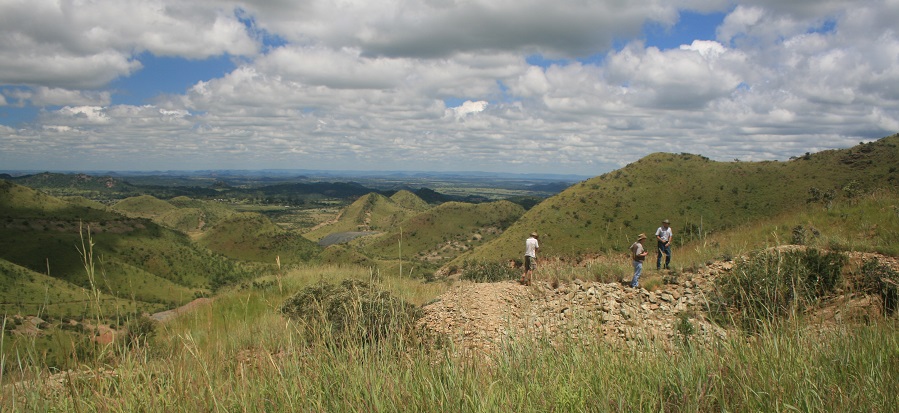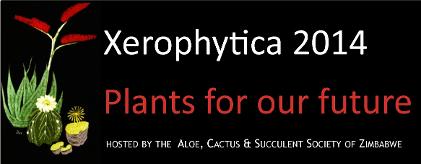
The Aloe, Cactus and Succulent Society of Zimbabwe
PO Box CY300, Causeway, Harare, Zimbabwe
aloe143@gmail.com www.facebook.com/ACSSZ
Telephone: +263 772 653 110
Xerophytica 2014 - Plants for our Future | Congress Announcement
The Aloe, Cactus and Succulent Society of Zimbabwe has in the past organised two highly successful international congresses: Aloe 75 and Aloe 88. Some 25 years have passed since our last such event, and, returning to our educational mandate, the Society is now organising a new international event. Our theme is : Xerophytica - Plants for our Future.
The African/Madagascan region is host to more than half of the world's succulent plant species. Humanity has been fascinated by succulents for millennia - for their medicinal and cosmetic uses, the colour they bring to landscapes, and the scientific questions they raise. More recently, succulents have also attracted the serious interest of collectors, and they are playing an increasingly important role in horticulture and landscaping, particularly with changing climatic patterns.
The congress will serve three main purposes: 1. to report on recent research and update scientific information; 2. to popularise succulents - broadly defined - as plants for both the home gardener and the commercial grower; and 3. to examine issues around the sustainable use of southern African flora and raise awareness of the threats to species survival posed by habitat loss. And, of course, for many there will be the enjoyment of renewing old acquaintances. The congress programme will look at all of these aspects. The presentations will stretch across plant scientists, naturalists, serious hobbyists, plant photographers, plant breeders, landscapers, specialists on interactions between succulents and birds and insets and others. All presentations will be accompanied by visual illustrations.
The formal programme will take place in Harare on Friday and Saturday, 20 and 21 June 2014. Optional post-congress tours begin on Sunday, 22 June 2014 with a picnic/braai outing to the Ewanrigg Botanic Garden, gifted to Zimbabwe by Harold Basil Christian. On the Monday there will be a full-day 4x4 trip to the Great Dyke, an area known for its diverse flora and home to Zimbabwe's signature Aloe ortholopha - and many other succulents. The remainder of the week will be filled with a 4x4 tour to the Eastern Highlands and/or southeast Zimbabwe depending upon the preferences of participants. Possibilities include the Bvumba Botanic Garden and the Chimanimani Mountains, where we feel sure there are species yet to be identified, and the drier habitats south of Chipinge. For our international participants, the Society is happy to assist you in arranging post-congress visits to popular destinations, such as Great Zimbabwe and Victoria Falls.
It has been far too many years since a congress of this nature was organised in Zimbabwe. We hope that you will be able to participate.
Pre-registration and pre-payment of Congress fees are required. Full details and registration forms are available here and on our facebook page.

|
Xerophytica 2014 reg form.docx Size : 58.633 Kb Type : docx |

|
Xerophytica 2014 reg form.pdf Size : 130.892 Kb Type : pdf |
Xerophytica 2014 - Plants for our Future | Congress Venue 20 - 21 June 2014 | Wild Geese Lodge
Two days of formal presentations will take place under thatch at the Wild Geese Lodge on the outskirts of Harare, Zimbabwe.
Wild Geese Lodge lies at the source of the Mazowe River, which downstream deposits the alluvial gold sought by the small-scale panners.It also overlooks the Mazowe Mountains in the distance, and closer is home to a variety of game in the sanctuary.
Wild Geese Lodge Address: 2 Buckland Lane (off Alpes Rd), Teviotdale, Harare, Zimbabwe
Co-ordinates: S 17.42.047, E 31.05.045
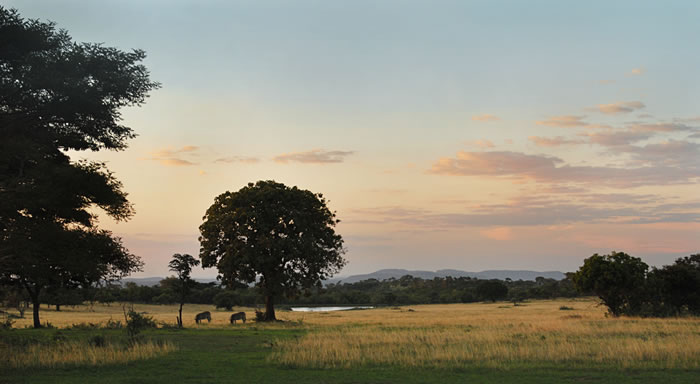
Wild Geese Lodge is set within a private wildlife sanctuary, offering thirty acres of indigenous garden and savannah at the source of the Mazowe River and overlooking the spectacular Mazowe Hills, yet located within fifteen minutes from Harare city centre. Guests can take the opportunity to walk in the savannah sanctuary surrounded by a diverse population of antelope, including majestic sable and eland, as well as zebra and others. A cocktail bar is situated just behind the reception area at the lodge and sundowners and other refreshments are also served in the seating area en route to the Congress venue.
Mobile Phone reception is available at the resort. Near the resort is any interesting nursery - Emerald Seedlings - with a large selection of indigenous succulents and other plants. The owner, Andy Roberts, is one of our presenters.
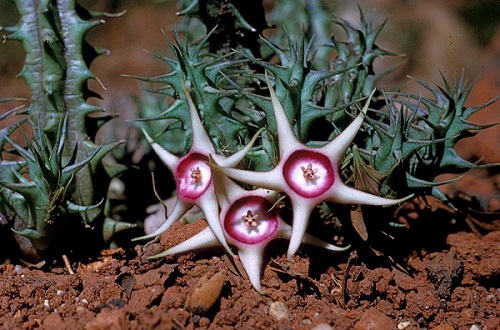
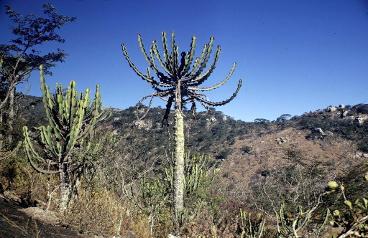
Xerophytica 2014 - Plants for our Future | Congress Programme
Friday 20 June 2014 | Wild Geese Lodge
08h30 - 09h30 Registration and Tea/Coffee
09h30 - 10h00 Welcome: Malcolm Thackray on behalf of the ACSSZ and Bill Kinsey: Plants for our Future
10h00 - 10h40 Presentation 1 - Neil Crouch: Signature Succulents of the Zulu
10h40 - 11h10 Tea/Coffee break
11h10 - 11h50 Presentation 2 - Ernst van Jaarsveld: Welwitschia mirabilis - Streamlined living fossil of the Namib Deset
11h50 - 12h30 Presentation 3 - Len Newton: Succulent plant discoveries in East Africa - Past, present and future
12h30 - 13h30 Lunch
13h30 - 14h10 Presentation 4 - Ben-Erik van Wyk: The commercial potential of southern African succulents in the herbal medicine industry
14h10 - 14h50 Presentation 5 - Tom McCoy: Aloes of Arabia
14h50 - 15h20 Tea/Coffee break
15h20 - 16h00 Presentation 6 - Andy Roberts: Botanical Photography Techniques
16h00 - 16h40 Presentation 7 - Mark Hyde: The Succulent Flora of Zimbabwe
16h40 - 17h30 Panel 1 - Darrel Plowes and all the day's speakers. Len Newton as Chair
18h00 - 22h00 Welcoming Function (dress: casual) NOTE: Cash Bar
Saturday 21 June 2014 | Wild Geese Lodge
08h30 - 09h00 Registration and Tea/Coffee
09h20 - 10h00 Presentation 8 - The Biggest Succulent-The Baobab sessions 1: Ralph Stutchbury: The Upside Down Tree
10h00 - 10h40 Presentation 9 - The Biggest Succulent-The Baobab sessions 2: Gus Le Breton: Baobab - Dryland Crop for the Future
10h40 - 11h10 Tea/Coffee break
11h10 - 11h50 Presentation 10 - The Cycad sessions 1: Piet Vorster: Hybridization in Cycads
11h50 - 12h30 Presentation 11 - The Cycad sessions 2: Philip Rousseau: The African endemic genus Encephalartos: The where & what of the rarest plants on earth
12h30 - 13h30 Lunch
13h30 - 14h10 Presentation 12 - Rolf Bekker: What's in a name: A perspective from the genus Euphorbia
14h10 - 14h50 Presentation 13 - Andrew Hankey: Mexico - A brief encounter
14h50 - 15h20 Tea/Coffee break
15h20 - 16h00 Presentation 14 - Tom Cole: The Aloes of Uganda
16h00 - 16h40 Presentation 15 - Buhle Francis: Opuntia fulgida: The Demon Invader in the Savannah
16h40 - 17h30 Panel 2 - Landscaping the Waterwise Way: Brian Terry, Tore Balance, Andrew Hankey and Chaired by Ernst van Jaarsveld
18h00 - 23h00 Closing Dinner (dress: casual) NOTE: Cash Bar
Ample time will be available during tea breaks, lunches and in the evenings for informal discussions. This will be a special opportunity to meet and interact with speakers and participants from all over the world.
Sunday 22 June 2014 | Ewanrigg (Post-Congress Outing)
09h00 Bus departs Wild Geese Lodge
09h30 Bus departs #2 Ridgeway South (cnr Enterprise Rd & Ridgeway South)
10h45 approximate arrival time at Ewanrigg Botanic Gardens
Ewanrigg Outing, tea/coffee and lunch included
15h00 Visit to the garden of Brian and Barbara Terry
afternoon tea served
PM Bus returns to #2 Ridgeway South followed by Wild Geese Lodge
Monday 23 June 2014 | Great Dyke (Post-Congress Tour)
08h00 Meet at Mount Pleasant Post Offices.
Full day 4x4 tour around the area of the Great Dyke (vehicles provided)
Great Dyke Tour, tea/coffee and lunch included
Tuesday 24 - 29 June 2014 | Eastern Highlands (Post-Congress Tour)
4 nights 4x4 Tour to the Eastern Highlands,
Full details of all Tours can be found further below - keep scrolling!
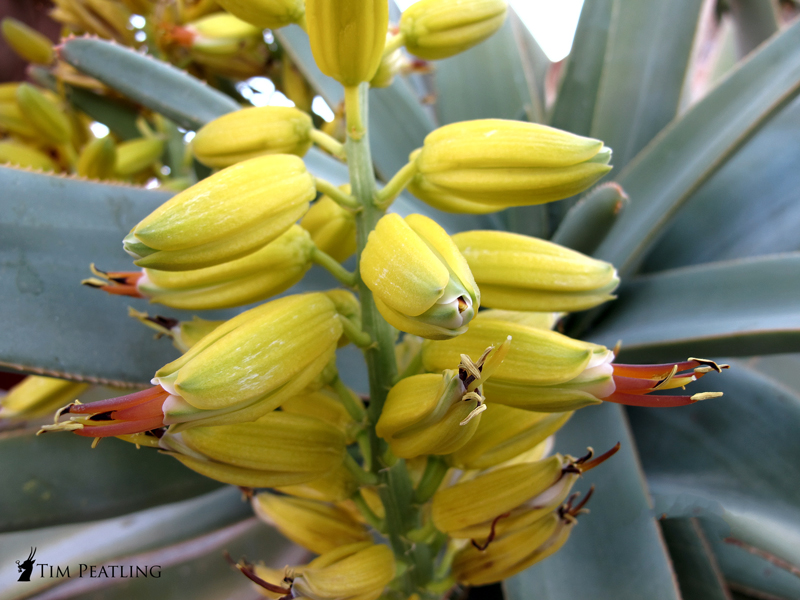
Xerophytica 2014 - Plants for our Future | Congress Presenters and Resources
Speakers are secured and confirmed. All details will be updated continually.
Presentations will include talks giving photographic pictures of the wealth and variety of succulent species not only from southern Africa, but also from further afield. Unique habitats in these areas will be discussed. Other presentations will look at recent plant discoveries and the rediscovery of some plant species. The use of succulents in traditional and modern medicine, their growing dietary importance, cosmetic uses, the horticultural importance of the plants, their role in landscaping, and the breeding - by accident and by intent - of new cultivars, will be treated as well. Although a number of presentations will be based on serious scientific research, every effort has been made to give the Congress a "hands-on" feel such that participants take away with them both an enhanced awareness of, and a lasting enthusiasm for the world of succulents. It is our intent to raise issues of importance in the sciences dealing with succulents, but to do so in ways that make them accessible to amateur botanists, gardeners, nurserymen and others.
Rolf Bekker: Rolf currently serves as the Executive Director at the South African Council for Natural Scientific Professions (SACNASP), which he joined in 2011 following a sabbatical of three years to pursue personal research interests. Previously, he joined the University of Limpopo in 1986 where he held posts as Professor of Biochemistry and as the Director of the School of Molecular and Life Sciences (2001 - 07). He did his junior degrees at the University of Port Elizabeth (now the Nelson Mandela Metropolitan University) and his PhD at the University of the North (now University of Limpopo), and then went on to do a BA in business administration. He has authored or co-authored numerous scientific papers, book chapters, popular science articles, and edited 3 books on his research specialities - the biochemistry of lithium and the taxonomy and distribution of southern African Euphorbia. As leader of a major research team between 1986 and 2002, he contributed over 120 presentations before scaling down research activities to concentrate on managerial duties. Rolf has served on numerous national and international bodies, including the Council of the Biochemistry and Molecular Biology Society of South Africa, the Education Committee of the South African Council for Natural Scientific Professions and the Board of Advisors for the International Society for Lithium Research. More recently he was appointed to the Accreditation Committee of the Council for Higher Education and joined the Board of the Institute of Certificated and Chartered Statisticians of South Africa. His current research interests focus on the genus Euphorbia and the effect of lithium on complex biological systems. Title of presentation: What's in a name? A perspective from the genus Euphorbia.
Thomas Cole: Tom has spent more than 20 years in sustainable agriculture, livelihoods, community development and humanitarian response work. Based in California, he has many years’ field experience across Sub-Saharan Africa—with significant time in Mozambique, Uganda and Ethiopia. He spends much of his spare time in these countries researching succulent plants. His focal areas are in urban agriculture, food production system design, post-conflict recovery, organic horticulture, agricultural extension, permaculture, natural resource management and livelihoods. Tom currently works as an agro-ecology and drought-management advisor for global USAID food security programs and provides technical support for numerous agricultural communities recovering from conflict. Previously he worked as the Africa Region Food Security and Livelihoods Advisor for Save the Children. Tom has a Masters degree in Humanitarian Assistance from the Friedman School of Nutrition at Tufts University, and is a 5-time world Frisbee champion. In 2011, he co-authored two new species of aloe from Uganda (Aloe wanalensis and Aloe butiabana), He is now busy working on a field guide to all of Uganda’s known Aloe species. Title of Presentation: “The Aloes of Uganda”
Neil Crouch: Neil Crouch studied at the University of Natal, where he was awarded his PhD in botany. For the past 20 years he has headed the Ethnobotany Unit of SANBI based in Durban, from where he has undertaken extensive fieldwork. He is also an honorary Professor in the School of Chemistry & Physics at the University of Kwa-Zulu Natal, based on his long-standing collaboration in the field of plant natural products. While researching the medicinal plants of the Zulu, Neil developed a strong interest in succulents of all forms, including underground ones (bulbs) and has published extensively in the Hyacinthaceae and Aloaceae. Related papers include several new species descriptions. He has co-authored books on medicinal plants and their trade, conservation and cultivation, and also on succulents, including Guide to Succulents of Southern Africa and Naturalised and Invasive Succulents of Southern Africa. He harbours a passion for ferns that led to the recent publication of Ferns of Southern Africa: A Comprehensive Guide. Signature Succulents of the Zulu (with Gideon Smith & Estrela Figuiredo)
Buhle Francis: Buhle is a Research Fellow and Lecturer in the institute of Development Studies at the National University of Science and Technology in Bulawayo, where she has been since completing her Master's at the University of Stellenbosch. Her recent research has centred on investigating the include of an invasive alien succulent - Opuntia fulgida - on the environment in the semi-arid savannah rangeland in southwest Zimbabwe (Matebeleland). Her work, which focuses on woody species diversity and surface soil nutrients in a communal area in Gwanda District, examines how the densities of O. fulgida affect the levels of major soil nutrients and the woody species richness and diversity of indigenous trees. A recent paper setting out her findings came first at the 8th Annual Arica Institute of South Africa African Young Graduates and Scholars Conference organised in collaboration with University of Johannesburg. Buhle was awarded a gold medal, a gold trophy, and a Certificate of Excellence. Title of presentation: Opuntia fulgida: The Demon Invader in the Savannah
Andrew Hankey: Andrew Hankey is the specialist horticulturist at the 300ha Walter Sisulu National Botanical Gardens in Roodepoort, Gauteng, where he has worked for the last 21 years. He is noted for his broad influence over the development of the WSNBG from the early years to what it is today. Among many other developments which characterise this unique and popular garden, he designed and constructed the popular Succulent Rockery and the unique Geological Display Garden. His interests in plants started as a child...Andrew, being the first cub in his pack to achieve the Gardener's Badge at the age of nine. Andrew is primarily focused on Southern African plants, although he does not limit himself to these. His research interest are primarily in the taxonomy of Ledebouria, Resnova and Drimiopsis, a group of bulbous plants in the Hyacinthaceae. Andrew has travelled extensively in the eastern parts of South Africa and has also visited neighbouring southern African countries such as Angola, Madagascar, Zimbabwe and Botswana. Title of Presentation: Mexico - A brief encounter
Mark Hyde: Mark Hyde was born and grew up in the UK. He became interested in plants at an early age and has always had a particular interest in weeds and alien plants. He was a contributor to Simpson's Flora of Suffolk (1982). Since coming to Zimbabwe in 1983, he has been actively involved in recording the flora of Zimbabwe and has made numerous field trips and written many articles on the flora. In 2002, he started the online Flora of Zimbabwe project which has since expanded to cover 3 countries (Zimbabwe, Zambia and Mozambique) and now has a team of 7 people plus other contributors. He is currently Chairman of the Tree Society of Zimbabwe. Title of Presentation: The Succulent Flora of Zimbabwe
Gus Le Breton: Gus Le Breton is an entrepreneur from Zimbabwe with a 20+ year track record in ethical, biodiversity-friendly natural products-related businesses across Southern Africa. Much of his business energy is devoted to developing new value chains from underutilized plants, and he currently owns and manages a natural cosmetics company, a baobab processing company and an early-stage herbal tea business. Gus also runs an innovation hub incubating new business opportunities in Zimbabwe around underutilized indigenous plant species (Bio-Innovation Zimbabwe) and acts as a business advisor to a number of small and medium-scale enterprises in this sector. Title of presentation: Baobab - Dryland Crop for the Future
Tom McCoy: For more than 30 years Tom McCoy has been researching aloes in their native habitats. During that time his travels have taken him to the northernmost known species to the southernmost. These travels have taken him to most all of the countries in which aloes occur naturally in Africa, Arabia and islands such as Socotra and Madagascar. During the course of these explorations, he has had the good fortune to encounter many new species of Aloe and bring them to light through his naming and formal descriptions of these new-to-science species. For the last 27 years, McCoy has been based in Saudi Arabia, allowing him unique access to one of the most closed societies in the world , and giving him the rare opportunity to investigate not only the aloes of Saudi Arabia, but also bordering countries such as the Yemen and Oman. Aloes have been an interest of his since childhood, and his activities are not confined to field research. At his ranch in California, he maintains a very large living collection of aloes, as well as the many other plant families of interest to him. Title of Presentation: Aloes of Arabia
Len Newton: Professor Emeritus, Kenyatta University, Kenya. Len has been interested in succulents since schooldays in England. His hobby influenced his choice of botany as a main subject at university and inspired him to spend most of his working life in Africa. For his PhD he worked on biosystematics of some tropical aloes. Whilst teaching at universities in Ghana and Kenya he took the opportunity to explore in various African countries, and in Arabia, and as a result he has described over 60 new species. He has published prolifically, and for six years was President of the International Organisation for Succulent Plant Study (IOS). Currently he is chairman of Succulenta East Africa, the local hobbyist group based in Kenya. Title of Presentation: Succulent plant discoveries in East Africa - past, present and future
Darrel Plowes: Darrel earned his BSc in agriculture, soil conservation and ecology at the University of the Witwatersrand before coming to work in what was then the Department of Agriculture in Southern Rhodesia. He continued his work in agriculture, working on the ecology of pastures and including a long stint as Provincial Agricultural Director, Manicaland Province, for 33 years while exploring in 17 countries in Africa and in Yemen in search of Stapeliads, which were to become his specialty. His spirit collection of Stapeliads is now housed in the National Herbarium in Harare. In recognition of his work, Darrel was made a Fellow of the Cactus and Succulent Society of America and an Honorary Life Member of the Aloe, Cactus and Succulent Society of Zimbabwe. In 1976, Longmans published his Wild Flowers of Rhodesia [with R. B. Drummond] for which Darrel provided all 193 colour plates, less than one percent of his large collection. He may be unique in terms of the breadth of species named after him: not just Stapeliads but also a legless lizard, a mole rat, an Aloe, a bird, a butterfly, and a flower.
Andy Roberts: Andy has an MSc in Horticulture from the University of KZN but his earliest influence came from his parents and growing up on a forestry estate in the Eastern Highlands. Forestry aside, his parents were both keen gardeners, and his mother was especially keen on her trees. Getting into horticulture was not a given; Andy started with agricultural engineering but struggled with the maths! His photographic credentials go back to the age of 14 when his parents, responding to his incessant badgering to use their camera, gave him one of his own. It was a cheap, plastic 35mm film camera, but it took surprisingly good photos that he learnt to process in the school darkroom. At university, he upgraded to his first SLR, a Nikon FM that stood him in good stead for many years, including a year's backpacking around the world. He still has this camera and it still works! Andy only really got keen on flower photography with the advent of digital and his first (and only) macro lens. He has remained loyal to the Nikon system with its full backward compatibility on all its F-mount lenses. Title of presentation: “Botanical Photography Techniques”
Philip Rousseau: Philip's love for cycads stems from a young age, as his father was an avid collector. While at high school, he completed an acclaimed expo project on the propagation of the critically endangered Encephalartos middleburgensis. From there, he completed his BSc. and BSc. Honours degrees under Prof. Braam van Wyk in Taxonomy. Philip then moved to the University of Johannesburg's African Center for DNA Barcoding to complete his MSc. on the molecular diversity in the African endemic cycads, Stangeria and Encephalartos. Philips is currently situated at the HGWJ Schweickerdt Herbarium at the University of Pretoria as a PhD candidate on the genus Encephalartos, under Prof. Braam van Wyk and Dr. Piet Vorster. The University of Pretoria, with one of the best Encephalartos collections worldwide, has always been the centre for cycad research and boasts a core of esteemed researchers and numerous postgraduate students completing theses on cycads. Philip also has a love for many succulent and bulbous families, especially of the South African Highveld grasslands which he calls home. Title of Presentation: The African endemic genus Encephalartos: The where & what of the rarest plants on earth.
Ralph Stutchbury: Ralph Stutchbury is a wildlife film maker based in Harare. Baobab trees were part of the landscape in which he grew up. Like many of us, he could never pass one of these extraordinary trees without taking a moment to look. It was almost inevitable that he would eventually make a film about them. The film led him to publish a coffee table book on the Baobab that is available for purchase at the congress. Further details of Ralph's work can be found at: http://www.ralphstutchbury.com/ Title of Presentation: The Upside Down Tree
Brian Terry: Brian is a local yokel who grew up in the bush. His first interest as a naturalist was birds (feathered). Later he became a teacher and interested in unfeathered birds, but he spent his courting days climbing kopjes and collecting Aloes. In this way he became aware of natural hybrids and began to collect them, later helping Dr Oliver West with his book on Aloes of Rhodesia. Subsequently he also began creating his own Aloe and other hybrids. Brian is qualified as a judge of the African Violet Society of America and is also qualified as an international Orchid judge. He was awarded a Bronze Medal by the Royal Horticultural Society for showing African Violet hybrids and had one named for the wife of the then Prime Minister of Rhodesia. He is a founder member and was the first Chairman of the Aloe, Cactus and Succulent Society of Rhodesia and became heavily involved in judging Aloe and Succulent shows, flower shows, Orchid shows and factory garden competitions. Brian and his wife Barbara also became very involved in teaching children about succulents and gardening in general through introducing the study of plants into the school curriculum at different levels and by taking schoolchildren on botanising tours.
Ernst van Jaarsveld: Enrst is a horticulturist at Kirstenbosch National Botanical Garden, Cape Town, where he curates the succulent plan collection both in the garden and nursery. His special interests are in the Aloe, Crassula and Mesemb families (Msembyranthemaceae) and waterwise gardening with the emphasis on growing succulent plants. His PhD at the University of Pretoria was earned through 10 years of study of the succulent and bulbous succulent flora growing on cliffs in southern Africa. He is a keen explorer and frequently visits remote habitats in South Africa, Namibia and Angola. He is also a keen grower of Welwitschia, and his latest book on Welwitschia will be available at the Congress. He is author of several other books, mostly dealing with succulent plants: Succulents of South Africa, Aizoaceae: Die mittagsblumen sudafricas / Les Mesembs D'Afrique du sud, Vygies, Gems of the Veld, Cotyledon and Tylecodon and Southern African Plectranthus: The art of turning shade to glad, and Waterwise Gardening (Struik 2010). Ernst is now busy revising his 1994 Gasteria book, as well as producing a book on his love for succulents growing on cliffs. He has named plants after each of his four children. Title of Presentation: Welwitschia mirabilis - Streamlined living fossil of the Namib Desert
Ben-Erik van Wyk: Studied forestry and nature conservation at Stellenbosch and went on to do his doctorate at Cape Town. Since 1984 he has been professor in the Department of Botany and Plant Biotechnology at the University of Johannesburg. Ben-Erik has particular interests in medicinal and useful plants, plant classification and chemosystematics of African plant families. His research has been published in numerous books, ranging from scientific treatises to field and garden guides, and some 300 research papers in scientific journals. He is also chairman of the Aloe Council of South Africa and of the Indigenous Plant Use Forum and served on the Presidential Task Team for African Traditional Medicine (2006 - 2008.) Awards for his contributions to botanical science include the Havenga Prize for Biology in 2006, the Silver Medal of the South African Association of Botanists in 2007 and the Vice-Chancellor's Award for the top researcher at the University of Johannesburg in 2009. Since 2013, he holds a National NRF Research Chair in Indigenous Plant Use and is leading a project to record and conserve traditional knowledge about useful plants. Title of Presentation: The commercial potential of southern African succulent plants in the herbal medicine industry
Piet Vorster: Studied at Pretoria University and earned a doctorate on the taxonomy of the sedge genus Mariscus. Following the example of his teachers, Vorster eventually specialised in cycads. He spent 11 years on the staff of the National Herbarium of Pretoria before moving to Stellenbosch University as research scientist. Over the years, he worked on the taxonomy of various plant groups such as the aforesaid Mariscus, Pelargonium, Amaryllidaceaea, and Encephalartos. Now retired, he still works on the Amaryllidaceaea and maintains an interest in Encephalartos. Title of Presentation: Hybridisation in Cycads.
Xerophytica 2014 - Plants for our Future | Costs
Payment can be made into the Society's CABS bank account - SWIFT transfer details are included on the registration form (please note that transfer costs are for your account - the Society will not accept these costs.)
2 Day Congress | $120.00 per delegate or $60 per delegate PER DAY
includes registration, congress bag, tea/coffee breaks, lunches & softdrinks, Welcoming Function and Closing Dinner.
(please note that there will be a cash bar for both evenings - you will need to bring US$ in cash)
(Kindly note that there will be a 10% discount for all ACSSZ members who settled their annual subscriptions timeously before the end of January 2014.)
Post-Congress outing to Ewanrigg Botanic Gardens | $25.00 per person
includes transfers, toll fees, entrance fees, tea/coffee, a packed lunch and limited drinks
(please note transfers are from Wild Geese Lodge and #2 Ridgeway South (cnr Enterprise Road))
Ewanrigg Botanic Gardens website
Post-Congress Tour to the Great Dyke | $35.00 per person
includes 4x4 transport in Society vehicles, toll fees, water, tea/coffee, a packed lunch and limited drinks
(please note transport is from the Mount Pleasant Post Office (a vehicle guard will be provided))
Post-Congress Tour to the Eastern Highlands| $400 per person sharing or $500 single (secure your place soon, as this amazing tour is limited to 25 people)
includes transport, toll fees, accommodation on a bed & breakfast basis, Botanic Gardens entrance and other tour itinerary items. Please see the Eastern Highlands Tour information for more details.
Tuesday : Meet at Paula's Place.
(note all drinks and some dinners are for your own account - you will need to bring US$ in cash)
Should you have any queries, kindly contact the ACSSZ Secretary, Bill Kinsey, on aloe143@gmail.com.

Registration Forms
for download - deadline 16 June

|
Xerophytica 2014 reg form.docx Size : 56.062 Kb Type : docx |

|
Xerophytica 2014 reg form.pdf Size : 139.06 Kb Type : pdf |
The above Registration Forms can be downloaded, completed, and emailed to aloe143@gmail.com or printed
Kindly advise us of your payment amounts and details so we may allocate the credit to your name.
Xerophytica 2014 - Plants for our Future | Art & Exhibitions
Complementing the presentations will be a 2 day exhibition and sale of plant-themed artwork, dietary and cosmetic products derived from succulents, products for the succulent gardener and succulent plant species. A number of exhibitions are planned during the congress - these will include an exhibition of botanically inspired art, a book exhibition, a display of aloe and other succulent products, and selected plant species. Artwork, as well as books will be for sale.
Confirmed Artists:
Lin Barrie - Artist: Lin Barrie received a Fine Art Diploma in print making at Durban Technikon in 1980, and pursues her passions (Painting, Conservation and Culture), from the wilderness home that she shares with Clive Stockil in the Save Valley Conservancy, and from her Harare Studio at 214 Brooke Drive, Borrowdale Brooke Estate, (partly burnt in a recent house fire, but still functioning!). Together with her father Arthur Barrie, she has recently landscaped the gardens at Chilo Gorge Safari Lodge with water-wise, indigenous plants. Email: linbarrie@gmail.com Mobile: 0772922148 or 0772 219204 Studio Landline: 04 860508
Lin Barrie Art -for updates and catalogue, visit my blog page, 'Art by Lin Barrie': http://wildlifeandwilddogs.wordpress.com/art/
Chilo Gorge Safari Lodge website: http://www.chilogorge.com/
Marlene Bornman: Being involved in the running of the family farming business, Marlene did not use her degree in Fine Arts for many years. Only after being forced to move to Harare in 2002 was she able to take up art full time and live out her passion. Although she has put her hand to most subjects in painting, she is always drawn back to plants, flowers or any organic form. She is competent in all media but of late has been working mainly in acrylics. Aloes have been her preferred plant for the last two years. What attracts her is the bold character of this hardy species and all the textures from the colourful flowers, to the interesting dead leaves which in themselves are a multitude of abstract shapes. She prefers to paint large...which is a challenge in itself! Owing to the size of her paintings, most have been bought by lodges, clubs or large home-owners. She has taken part in many art exhibitions and has paintings in London, America, Spain, Cape Town, Zambia, Mozambique and South Africa.
Contact details: Email: mbornman@mango.zw Phone: +263 772 239 219
Judy Carter: Judy grew up on a farm in the Lomagundi area. In the 1950's, wild flowers grew in abundance on the farm, but she noticed that the grazing by cattle diminished the flowers year by year, until certain species disappeared altogether, particularly the ground orchids. Her natural talent for illustration, as well as a great love for plants and a desire to record them, were her reasons for becoming a botanical artist. Her grandfather, the late Percy Sheppard (1875 - 1958), was a well-known naturalist in Zimbabwe. He had species of birds, butterflies and insects named after him, and he also illustrated some of these in much detail. He served as a great inspiration. Judy started out as a teacher of History, English and Biology, but left teaching to go farming with her husband, and they developed a large dried-flower business in Bromley near Marondera. In 2004, they left Mashonaland and settled in Bulawayo, where she has a small fresh-flower business and a much bigger business helping with four grandsons in Bulwayo and two in Munich. As an artist, Judy is self-taught, and the medium she uses is watercolours. Her cards, as well as those of her grandfather, are on sale at the Congress.
Contact details: mailto:carter@yoafrica.com
Heather Gulliver: Heather was born and brough up in Harare, educated at Chisipite and did Sixth Form College in Bulawayo and spent much time at Nyanga. Around 1960, she decided the best thing for her was to be an artist. In 1971, after A-level, she went to France to language school (Alliance Francaise) and art school - Atelier Met de Penninghen et Jacques d'Andon Paris - seeking high culture. Later she moved to Cambridge in England, married, then moved to Bath and set up an etching studio and taught life drawing. Two children were born in 1979 and 1982. At this point, Heather changed her work to abstract painting and drawing but, as landscape was the basis of all her abstract works - and naturally the landscapes of her formative years, she moved back to representational work. The African bush and all its incredible detail - the wilder the better - is the subject of choice. And using her depictions to promote conservation and preservation is the ambition.
Contact details: Email: mailto:hgulliver@outlook.com Web: http://www.hgulliver.com/ and http://heather-gulliver.culturalspot.org/
Richie Gunner: Richie Gunner is a crop researcher/horticulturist by profession, but he has been an enthusiastic photographer since childhood and has done professional photographic assignments on and off all his working life. He has an abiding fascination with how many indigenous plants in Zimbabwe manage to push up the most beautiful, delicate blooms during the driest, hottest time of the year, when nothing seems to be growing. His desire to capture images of these blooms within the rough, alluring shapes and texture of the Musasa (Brachystegia) trees at this time of year has led him to produce the series of greeting cards - Wild Flowers of Musasa Woodland in Harare - on sale at the Congress
Contact details: Email: mailto:rgunner@zol.co.zw Phone: +263 774 456 215
Ann Mingay: Ann is a watercolour artist, living in Cape Town. Her love of plants and landscape is demonstrated with her experienced, delicate touch. Watercolours of Aloe. tenuior and Aloe. ciliarus can be found in the latest Ingens magazine. A selection of greeting card prints will be on sale at the Congress.
Kate Raath: Kate is Zimbabwe born and bred and was raised on a cattle ranch in Masvingo province. She did her undergraduate degree in Fine Art at Rhodes University and went on to do diplomas in Design for Print and Graphic Design. After working in commercial printing in South Africa, she returned to Zimbabwe, where she has taught art in secondary schools, in the National Gallery of Zimbabwe Workshop School, and in the art department of Harare Polytechnic. Alternating with stints of teaching fine arts and craft skills, she has also pursued her own textile craft. With numerous awards and exhibitions over 40 years, Kate remains dedicated and passionate about art, constantly learning and improving her skills. She is highly respected locally and internationally as an elder statesperson of Zimbabwe art and served as a principal judge in Visual Arts for the National Institute of Allied Arts and as a member of the judging panel for embassy-sponsored art competitions at Gallery Delta. Kate currently stays busy with full-time painting, with her textile craft, and with revising the Art History content of her degree.
Contact details; Email: mailto:k_art@mango.zw Phone: +263 4 302 683 Web: http://www.zimbabwefineart.com/
Dot Tayler: Dot lived in the lowveld of Zimbabwe for over 40 years and could not help but be inspired by the bush, so she developed a passion for Baobabs and Aloes. This is reflected in her art, which she has created using various techniques and media over the years. Dot studied under local artists, Jean Hahn and Martin can der Spuy, and her mother was Betty Bomley, who was a well-known flower and landscape artist. Dot also operates a cottage industry called S.E.E.D Design, where her ethnic designs are embroidered by African women in the lowveld. These works have been incorporated into framed pictures, bags, wall hangings, cushion covers, etc.
Contact details: Phone: +263 4 495 441 or +263 772 284 825. Email: mailto:savuli@mweb.co.zw
For more information, contact the ACSSZ Secretary, Bill Kinsey, on mailto:aloe143@gmail.com, or by phone on +263 772 653 110.

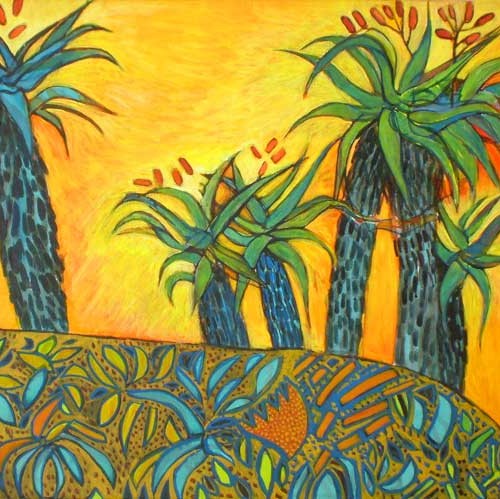

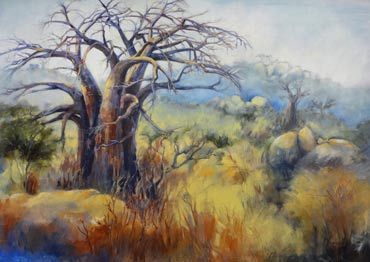
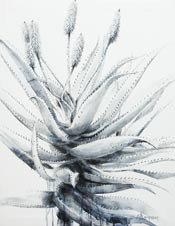
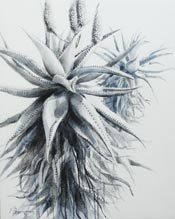
Xerophytica 2014 - Plants for our Future | Weather & Gear
Recommended Gear and anticipated weather conditions:
Weather:
Weather for the end of June is typically blue skies and chilly with warm days in Harare! The Congress takes place on the shortest day of the year in the southern hemisphere! However, the Eastern Highlands is definitely going to have a deep chill, so pack appropriately!
Harare averages for June are a low of 8 degrees C and highs of 18 degrees C. The average daily temperature is 14 degrees C. In a normal year, Zimbabwe experiences ground frosts in June. This year, our rains have ended earlier than usual (and aloes seem to be flowering early), so we expect colder than normal weather for the Congress. This certainly means fleeces and jackets in the mornings and evenings, although you may well shed these in the middle of the day. (Central heating does not exist in this part of the world!) Sunshine hours are typically 9 hours.
Gear and items for packing:
We suggest that you pack the following items:
The weather is refreshing rather than challenging. One thing you will need, particularly on the tours, is a good hat. Even our mid-winter sun is fierce, especially for those from northern climes. Do pack your suntan lotion. For those going on the 4x4 Post-Congress tours to the Great Dyke and Eastern Highlands, stout walking shoes/boots are strongly advised. Secure footing in some locales is essential.
Although we do not get rain in June, the Nyanga area is known for the heavy mists that can shroud the mountains and leave you drenched. Remember to pack a torch (power outages are numerous!), and warm clothing, especially for the nights,
Pack your mosquito repellent (we should be avoiding malaria areas, and the cool weather should mean few mozzies! However, please do consult your medical practitioner for more information and advice.)
And of course, don't forget your camera, SD cards, journal, reference books and spending money in US$ cash if at all possible (credit card machines are not readily available around the country.)
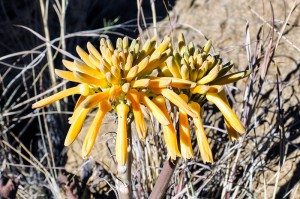
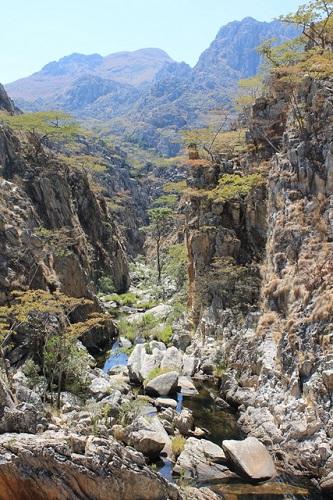
Xerophytica 2014 - Plants for our Future | Accommodation & Transport
Accommodation options in Harare:
Wild Geese Lodge: http://www.wildgeeselodge.com/ +263 4 293 0379
Wild Geese Lodge: single $117, double $133 per night
Cresta Hotels: http://www.crestahotels.com/hotels/Harare +27 11 881 1200 / +263 4 788 161/2
Cresta Lodge Harare (3+ star):
Weekday single $102, double $118 per night. Weekend single $85, double $98 per night
Cresta Oasis (3 star):
Weekday single $85, double $102 per night. Weekend single $71, double $84 per night
Cresta Jameson (2 star):
Weekday single $57, double $74 per night. Weekend single $43, double $60 per night
Meikles Hotel: http://www.meikles.com/ +263 4 707 721
Meikles Hotel: rates from single $200 , double $225
Portsalon Private Lodge: http://www.portsalon.co.zw/ +263 4 883 738 / +263 773 436 123
Portsalon Private Lodge: single $140, double $180
Accommodation options in Eastern Highlands:
Rhodes Nyanga Hotel: http://www.rhodesnyangahotel.com/ / +263 779 478 645
Kweza / The Farmhouse / Torhaven: dougvan@zol.co.zw +
Frog & Fern: http://www.thefrogandfern.com/ Jane +263 775 920 440
Transport and Shuttles:
Conquest Tours: http://www.tigerbayresort.webs.com/ +263 772 239 134 (Shuttle Service between Harare International Airport and Borrowdale ZUVA service station.)
Nyati Travel & Tours: http://www.nyati-travel.com/ +263 4 495 804
Shuttle Safe: http://www.shuttlesafezim.com/ +263 777 593 979
For those who would like to come early or stay beyond the post-Congress tours to do additional botanizing and/or garden visits, the accommodation listed here is available, or the steering committee is happy to assist you in finding accommodation that would fit in better with your plans. Similarly, if you would like to visit any of Zimbabwe's well-known tourist attractions, the steering committee is glad to send you to the best people for making such arrangements.
Xerophytica 2014 - Plants for our Future | Post-Congress Outings and Tour information and details
The post-Congress Tours have also been designed with two specific purposes: to allow us to take the speakers and participants to special plant habitats in Zimbabwe, and to draw on our speakers as resource persons to enhance our knowledge and strengthen the way we seek to conserve our plant resources.
The 4x4 format for the Great Dyke and Eastern Highlands tours is deliberate: for several reasons. First, some places we'll go, only a 4x4 can reach. Secondly, using multiple vehicles will allow each vehicle to stop at features of interest to occupants rather than being constrained by the consensus of a full busload.
Finally at each stop, passengers will be rotated among vehicles to maximise mutual learning.
Sunday 22 June 2014 | Ewanrigg Post-Congress Outing | Tour One
After a slow start to allow for recovery from the two preceding hectic days, we shall leave Wild Geese by bus at 09h00 for Ewanrigg Botanic Garden, the gift to the nation by Harold Basil Christian. Local participants wishing to travel on the bus should leave their vehicles at #2 Ridgeway Road (cnr. Enterprise Road) where they will be collected at 09h30.
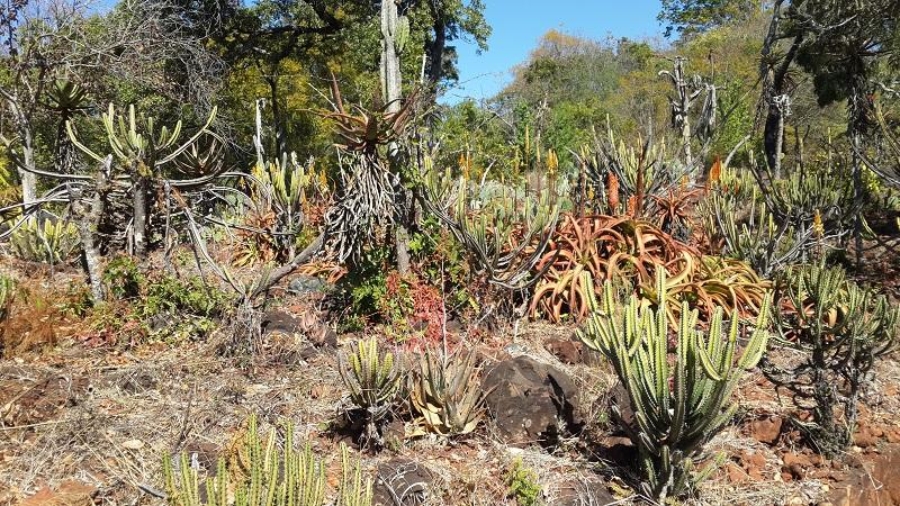
Ewanrigg lies some 30km northeast of Harare and is one of the world's largest aloe and cycad gardens, with a wide range of species of each.
Upon arrival, we shall have tea/coffee, be welcomed by the Curator of Ewanrigg, and hear a short history of the plant collection.
You will then be free to wander the garden until we reassemble for a picnic lunch and drinks.
Following lunch, there will again be time to explore until we leave to return to Harare, and a leisurely visit to the inspirational garden of Brian and Barbara Terry in the late afternoon, where another warm cup of tea will be waiting!
Monday 23 June 2014 | The Great Dyke 4x4 Post-Congress Tour | Tour Two (4x4 vehicles are provided)
This tour takes us to one of Zimbabwe's geological singularities - the Great Dyke, an intrusion of mineral-rich materials visible from space.
The geological complexity of the Great Dyke and toxicity of some of the minerals have led to the evolution of unique plant species, including Zimbabwe's signature Aloe ortholopha.
International participants will be collected from their accommodation between 08h00 and 08h30. Local participants wishing to join the group should park their vehicles at the Mount Pleasant Post Office at 08h00. Vehicles will be guarded. while you are hosted in a Society 4x4 vehicle, Departure will be at 09h00.
Our circular route will take us north from Harare before we turn west to cross the Dyke and drive part of its length. In places, the terrain is marked by the diggings of informal sector miners along the tilted chromium seams, as well as the remains of large-scale commercial mining. In addition to the aloes, we'll see, among many others, Euphorba memoralis, E. matabalensis, and E. wildii.
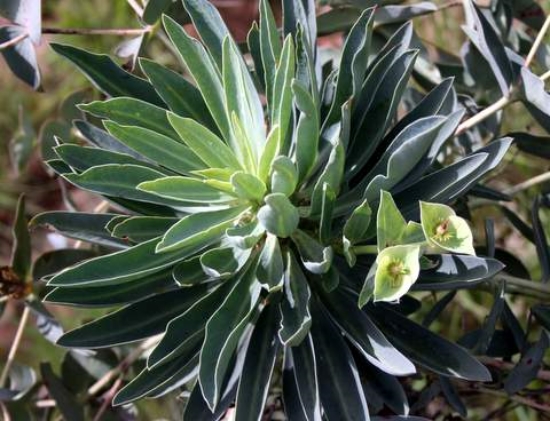
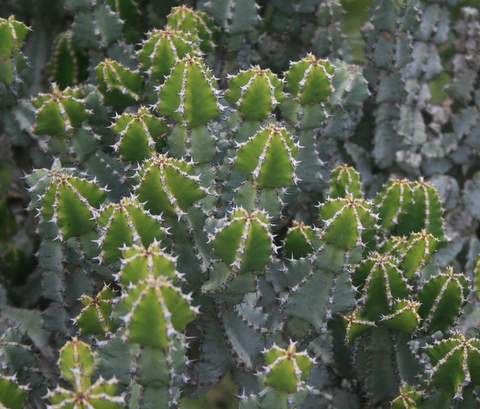
We shall break for coffees/teas and a picnic lunch before exploring some of the passes that dissect the Dyke and continuing west and crossing from the chrome belt back to the granite zone, and a completely different vegetative landscape. We shall return to Harare in the late afternoon.
Tuesday 24 June - Sat/Sunday 28/29 June 2014 | The Eastern Highlands 4x4 Post-Congress Tour | Tour Three
A 5 day circular tour of selected locations in the Eastern Highlands
Tuesday 24 June 2014
Vehicles will meet at Paula's Place on the Mutare Road for a 09h00 departure. We then travel to Halfway House and leave the main road for the Muller's place, where we shall have brunch and admire their cycads and other plants. From the Muller's, we continue on farm roads to Rusape and turn towards Nyanga. On the way to Nyanga, we'll explore several habitats, including the location of a spectacular colony of Aloe. cameronii var bondana from which the type specimen comes. We may be lucky enough to find Aloe. pretoriensis, A. carnea and A. chabaudii in addition to A. cameronii although with the long grass and late flowering time, it will be luck indeed. We'll overnight (for two nights) at the Rhodes Nyanga Hotel. http://www.rhodesnyangahotel.com/
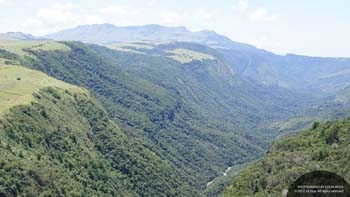
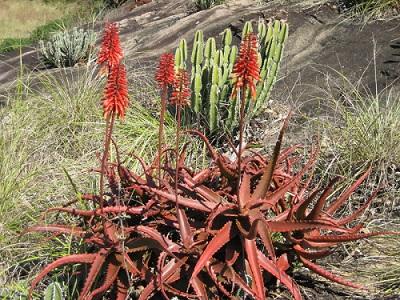
Wednesday 25 June 2014
Today we explore the Nyanga area. Again we can expect to find aloes endemic to the Eastern Highlands. The two varieties of Aloe. inyangensis are possibilities, as is the small grass aloe, Aloe. myriacantha. Aloe. pretoriensis has been reported here in the past, but, as there are few records, this is our chance to provide an update. We will also hunt for a sighting of Aloe. collina. There is an as yet unidentified, undescribed pendant Aloe growing on the face between the Mtarazi Falls, as well as an unnamed Kniphofia in the gorge below the Pungwe Falls. Huernia hislopii occuse among rocks on either side of the bridge above the bathing pool and it may still be in flower.
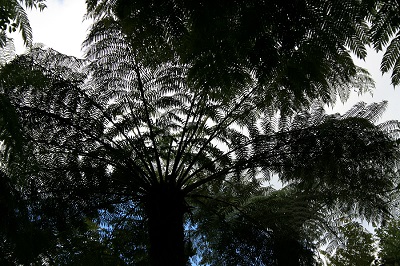
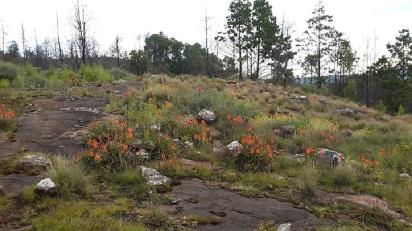
Thursday 26 June 2014
Our destination today is Chimanimani Village (1588m), some 150km south of Mutare.

We return toward Mutare before turning south and driving roughly parallel with the Odzi River to the turn-off to Cashel. In Cashel, we again turn south and follow the dirt road - slowly! - through the Tandai Forest Land and tracking the Mozambique border to the east. This will be a day of many stops and starts, and participants are free to choose what they'd like to investigate at close range. Possible sightings today include Huernia cashelensis growing among rocks at the top of a pass, Aloe musapana,Aloe wildii, and Aloe. rhodesiana.
We shall also stop for a picnic lunch enroute.
We overnight at http://chimanifarmhouse.com/the-house/ and http://www.thefrogandfern.com/about
Friday 27 June 2014
This is the day when any kinks from road travel will be worked out. We retrace our steps of the previous day as far as the turn-off for The Corner, where the need for 4x4's will become obvious.
The day will be spent clambering up the gorge carved by the Musapa River and looking for cremnophytes on the steep rock walls.
Today we can expect to sight Aloe. munchii, Aloe wildii where the sandstone starts, and perhaps Aloe. musapana on one of the watercourses, if we are lucky...and have the energy to climb Mr. Musapa, which it calls home. The trek up the Musapa River passes several groups of Raffia farinifera palms whose leaves are among the largest in the plant world in old mature specimens. Euphorbia rugosiflora is endemic here.
As we bypass the falls and rapids of the river, we are struck with what looks like trees wearing fur coats. Closer inspection, however, will reveal that the tree trunks are densely clad in small, indigenous orchids. The orchids that cloak some of the stems and rocks near the camp-site waterfall at The Corner, are various species of Bulbophyllum.
Another overnight at the Farmhouse and Frog and Fern will allow us to rest our aches and pains before returning to Harare.
Saturday 28 June 2014.
Today's route takes us from the Chimanimani Mountains, into completely different terrain - the low, dry country bordering the Save River.
Before crossing Birchenough Bridge, we may find the Travellers' Tree, which is a large hollow baobab with names and initial of early travellers inscribed into it. It is on the east bank of the Devure River beyond Birchenough Bridge. There may be some Stapelia gettlefii still in flower below the Bridge. There are small colonies of Aloe globuligemma as well as Aloe littoralis and Euphorbia cooperi if we are on the right route and find sufficient time.
Across the Save, we travel through a very different landscape, on the way to the turn where we head northwards through Gutu and extensive Aloe-spotted grasslands and home. On the Masvingo Road, west of Moodie's Pass one sees Euphorbia confinalis in addition to Euphorbia cooperi and Euphorbia ingens.
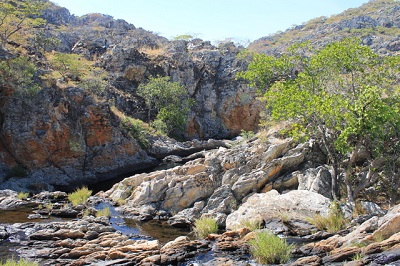
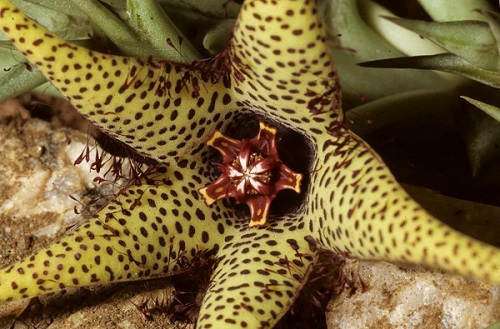
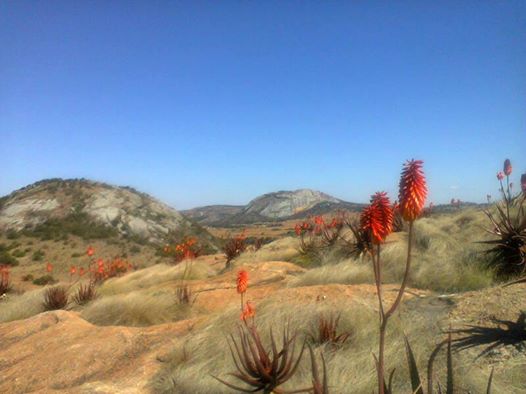
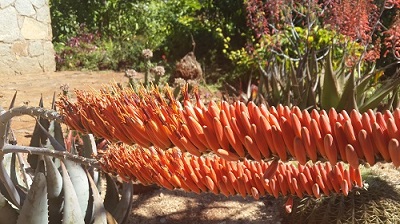
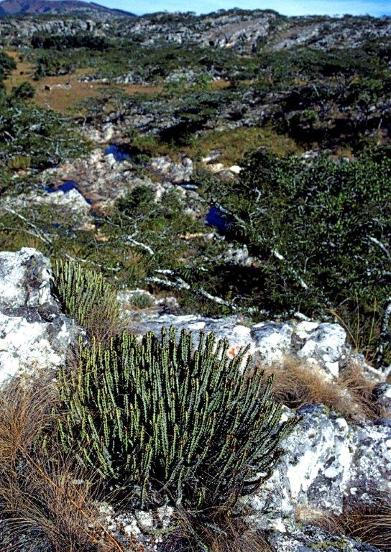

Xerophytica 2014 - Plants for our Future | Sponsors & Affiliations
A huge thank you to our sponsors, including Citchem, BIZ - B'AYOBA, Nico Orgo. and many more that will be listed on an ongoing basis.
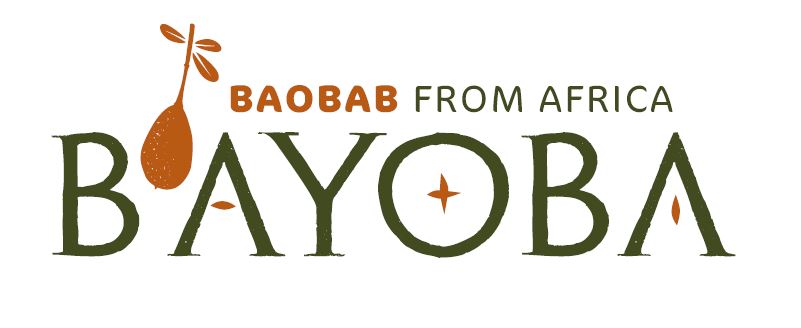
B’Ayoba is a leading producer of baobab products, ethically and sustainably harvested in partnership with rural producer communities around Zimbabwe. Our baobab is fully organically certified, and meets the highest international quality standards. http://www.bayoba.biz/

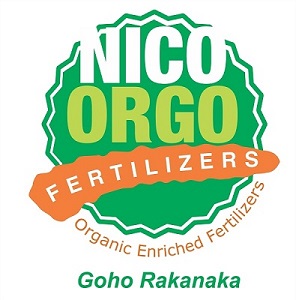
Nico Orgo Manures an ISO 9001-2000 certified company offers a wide range of organic inputs for sustainable agriculture and horticulture. These products specially address the serious modern day concerns about environmental degradation and the threat posed to human health as a result of chemical inputs. Nico Orgo products are bio-degradable, environment friendly, protect crops naturally, are safe to use and at the same time help increase crop yields. Their products have been successfully used in Integrated Crop Management (ICM) systems. http://www.neemnico.com/
Mike Danes of DANES design sponsored a large portion to the redrawing and redesign of the Aloe, Cactus and Succulent Society of Zimbabwe's logo.
PrintWorks - Complete print & digital solutions. Business cards, letterheads, compliment slips, flyers, posters, leaflets, tags, gift certificates, invoice books, receipt books, diaries, stationery, publishing, magazines, cards, calendars, variable data, QR codes, Web2Print, online printing, graphic design, branding, corporate identity, company logos, vehicle wraps, wide-format, outdoor banners.
Cit Chem (Private) Limited is a fully registered and operational private company in Zimbabwe and its prime function is the distribution of crop protection chemicals in Zimbabwe. The company was established in 1996 and has been in operation for 15 years. We have an extensive range of approximately 120 chemical registrations that have been approved by the Ministry of Agriculture’s department of Plant Protection and Research Institute. http://www.citchem.com/

TEXTACASH: Low cost, easy to open bank account. No minimum balance and no monthly service charge. All you need is your ID.

CABS is an established and strong brand name in the financial retail market in Zimbabwe. The Society offers a diverse range of financial products and services that includes transaction and savings accounts, mobile banking, mortgage loans, money market investments, term deposits and pay-roll loans. These are delivered through the largest branch network in the country which is linked to CABS on-line real time banking system.
CABS is a subsidiary of Old Mutual Zimbabwe, Zimbabwe's largest life assurance organization. Old Mutual Zimbabwe is in turn a subsidiary of Old Mutual PLC - an international financial services conglomerate.
CABS is committed to the practice and maintenance of the highest standards of corporate governance. To this end CABS works within the framework of the Combined Code on Corporate Governance and Best Practice implemented through the offices of the Board of Directors. The Board, consisting of both executive and non-executive directors, monitors financial and operational performance through regular meetings. Through the disciplined implementation of internal controls and systems, CABS ensures accountability and accuracy in the preparation and presentation of its financial statements. In addition, internal and external committees meet regularly to monitor and report on a number of issues deemed to be in the interests of sound corporate governance. These include: an Independent Board Audit Committee, a Board Loans Review Committee, Board Credit Committee, a Board Risk & Compliance Committee, an Executive Committee (EXCO), an Asset & Liability Committee and a Management Credit Committee.

Xerophytica 2014 - Plants for our Future | Registration Forms for download
The below Registration Forms can be downloaded, completed, and emailed to aloe143@gmail.com or printed & faxed to +263 772 653 110. Kindly advise us of your payment amounts & details so we may allocate the credit to your registration.

|
Xerophytica 2014 reg form.docx Size : 56.062 Kb Type : docx |

|
Xerophytica 2014 reg form.pdf Size : 139.06 Kb Type : pdf |
© CAS 2013 Harare | webdesign and hosting conpleted and sponsored by Caryl Stutchbury

